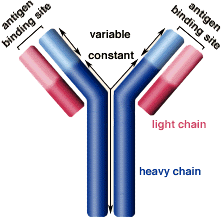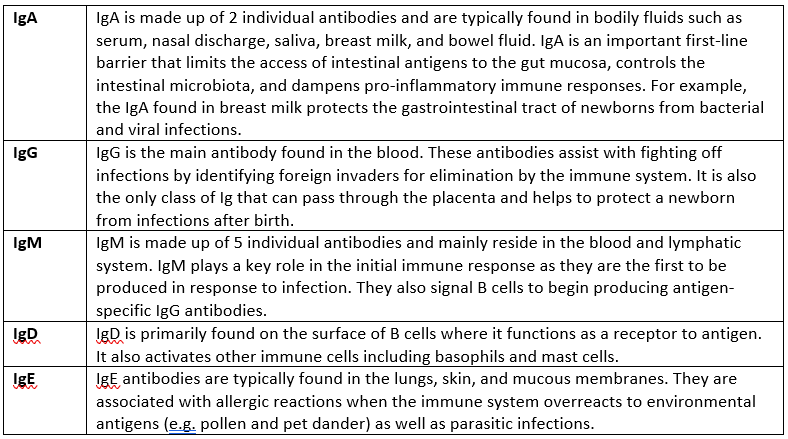A Deep Dive into Antibodies
In our first article Immunology 101: Innate and Adaptive Immunity Explained, we briefly described the vital role of antibodies within our immune system. In this blog post we take a closer look at antibodies to better understand their structure and the roles they play in the human body.
Where do antibodies come from?
Antibodies circulate within the bloodstream and appear almost everywhere in the body. They are tasked with recognizing and binding to foreign molecules, called antigens, which are often present on invading microorganisms. Types of antigens may include disease-causing bacteria, viruses, fungi, and various other substances like toxins, chemicals, and foreign particles. Dust, pollen, and certain foods that cause allergic reactions may also act as antigens.
Antigens may also be immunogens, meaning they are capable of triggering an immune response, which would in turn lead to the generation of antibodies. When antibodies are bound to the target immunogens, they trigger a cascade of immune reactions to help eliminate the foreign invaders.
What do antibodies look like?
Antibodies are generally expressed in the shape of a Y, which consists of two identical light chains and two identical heavy chains. The terms “light” and “heavy” refer to the relative size of the chains. Please refer to Figure 1 below for a representation of the antibody structure:
Figure 1
The Structure of an Antibody
(University of Arizona, 2000)
Each antibody chain is composed of a variable region and a constant region. The sequence and structure of the variable regions change depending on the target antigen, while the constant regions have a generally consistent structure across antibodies.
The tips of the variable region are the antigen binding sites. The shape of the antigen binding site is specific to the antigen it is targeting. If part of the antigen (epitope) fits into and binds to part of the antigen binding site (paratope), the antibody “recognizes” the antigen and binds to it through a lock-and-key mechanism. By binding to an antigen, an antibody can stop the antigen from entering or damaging human cells. This is often known as a neutralizing antibody. Antibody binding may also ‘tag’ the antigen for elimination by other parts of the immune system.
Millions of antibodies with slightly different antigen binding sites exist, with each variant binding to a specific antigen. The enormous diversity of antibodies allows the immune system to identify an equally diverse range of antigens.
Are there different types of antibodies?
Antibodies are also referred to as immunoglobulins (Ig). There are five naturally occurring classes of immunoglobulins termed immunoglobulin A (IgA), immunoglobulin G (IgG), immunoglobulin M (IgM), immunoglobulin D (IgD) and immunoglobulin E (IgE). Each class of Ig functions differently within the body.
Antibodies play a key role in the activation of our immune system and they help direct the appropriate immune response for each different type of foreign invader.
If you’d like to read about the general applications of antibodies, in this article we provide an overview of antibody applications in the field of biomedical research, diagnostics, and drug therapy development.
References:
Antibody Genes and Diversity. (2021, January 3). Retrieved August 3, 2021, from https://bio.libretexts.org/@go/page/11787.
Litman, G. W., Rast, J. P., Shamblott, M. J., Haire, R. N., Hulst, M., Roess, W., Litman, R. T., Hinds-Frey, K. R., Zilch, A., & Amemiya, C. T. (1993, January 1). Phylogenetic diversification of immunoglobulin genes and the antibody repertoire. OUP Academic. https://academic.oup.com/mbe/article/10/1/60/1030046.
National Institute of Allergy and Infectious Diseases. (2003, September). Understanding the Immune System. How It Works. National Institutes of Health. http://www.imgt.org/IMGTeducation/Tutorials/ImmuneSystem/UK/the_immune_system.pdf.
Pabst, O. (2012, October 29). New concepts in the generation and functions of IgA. Nature News. https://www.nature.com/articles/nri3322#citeas.
Petar, P., Dubois, D., Rabin, B. S., & Shurin, M. R. (2007, May 9). Chapter 12 - Immunoglobulin titers and Immunoglobulin subtypes. Measuring Immunity. https://www.sciencedirect.com/science/article/pii/B9780124559004502749?via%3Dihub.
Stokes, J., & Casale, T. B. (2020, October 8). The biology of IgE. Uptodate. https://www.uptodate.com/contents/the-biology-of-ige/print.
University of Arizona. (2000, June 12). Antibody Structure. The Biology Project. http://www.biology.arizona.edu/immunology/tutorials/antibody/structure.html.










